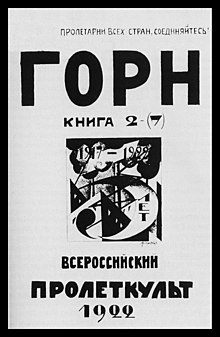
Back Proletkult Afrikaans Proletkult Czech Proletkult German Proletkult Esperanto Proletkult Spanish Proletkult Estonian Proletkult Finnish Proletkoult French תרבות פרולטרית HE Proletkult Hungarian
Proletarian Culture | |
Пролетку́льт | |
 Cover of Gorn (Furnace), an official organ of Proletkult, designed by Aleksandr Zugrin | |
| Formation | October 1917 |
|---|---|
| Founder | Anatoly Lunacharsky |
| Founded at | Moscow |
| Dissolved | October 1920 |
| Location | |
Membership (1920) | 84,000 |
Key people | Anatoly Lunacharsky Alexander Bogdanov Larissa Reissner Fedor Kalinin Pavel Lebedev-Polianskii Valerian Pletnev Platon Kerzhentsev |
Main organ | Proletarskaya Kul'tura |
Parent organization | People's Commissariat for Education |
Proletkult (Russian: Пролетку́льт, IPA: [prəlʲɪtˈkulʲt]), a portmanteau of the Russian words "proletarskaya kultura" (proletarian culture), was an experimental Soviet artistic institution that arose in conjunction with the Russian Revolution of 1917. This organization, a federation of local cultural societies and avant-garde artists, was most prominent in the visual, literary, and dramatic fields. Proletkult aspired to radically modify existing artistic forms by creating a new, revolutionary working-class aesthetic, which drew its inspiration from the construction of modern industrial society in backward, agrarian Russia.
Although funded by the People's Commissariat for Education of Soviet Russia, the Proletkult organization sought autonomy from state control, a demand which brought it into conflict with the Communist Party hierarchy and the Soviet state bureaucracy. Some top party leaders, such as Lenin, sought to concentrate state funding and retain it from such artistic endeavors. He and others also saw in Proletkult a concentration of bourgeois intellectuals and potential political oppositionists.[citation needed]
At its peak in 1920, Proletkult had 84,000 members actively enrolled in about 300 local studios, clubs, and factory groups, with an additional 500,000 members participating in its activities on a more casual basis.